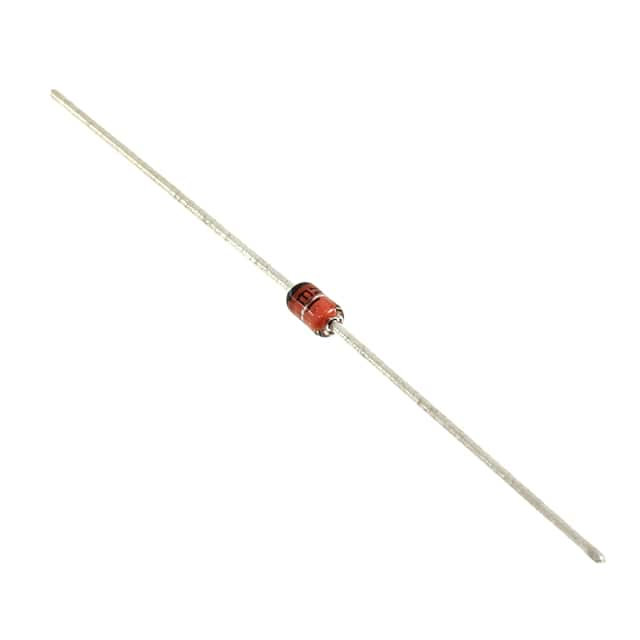1N4751ATR
Product Overview
Category
The 1N4751ATR belongs to the category of Zener diodes.
Use
It is commonly used for voltage regulation and voltage reference applications.
Characteristics
- Zener voltage: 30V
- Power dissipation: 1W
- Package type: DO-41
- Operating temperature range: -65°C to +200°C
- Packaging: Tape and reel
Package Essence
The 1N4751ATR comes in a DO-41 package, which is a cylindrical through-hole package with two axial leads.
Packaging/Quantity
It is typically packaged in reels containing a specific quantity, such as 500 or 1000 units per reel.
Specifications
- Zener voltage: 30V
- Power dissipation: 1W
- Maximum forward voltage: 1.5V
- Reverse current: 5μA
- Temperature coefficient: 5mV/°C
Detailed Pin Configuration
The 1N4751ATR has two pins, with the anode connected to one pin and the cathode connected to the other.
Functional Features
The 1N4751ATR operates as a voltage regulator by maintaining a constant output voltage across its terminals, even when there are variations in input voltage or load current.
Advantages and Disadvantages
Advantages
- Precise voltage regulation
- High power dissipation capability
- Wide operating temperature range
Disadvantages
- Limited voltage options compared to other Zener diodes
- Sensitive to temperature changes
Working Principles
When the voltage across the 1N4751ATR exceeds its Zener voltage, it begins to conduct in the reverse direction, effectively regulating the voltage across its terminals.
Detailed Application Field Plans
The 1N4751ATR is widely used in various electronic circuits, including: - Voltage regulators - Overvoltage protection circuits - Voltage reference circuits
Detailed and Complete Alternative Models
Some alternative models to the 1N4751ATR include: - 1N4749ATR (Zener voltage: 27V) - 1N4750ATR (Zener voltage: 28V) - 1N4752ATR (Zener voltage: 31V)
In conclusion, the 1N4751ATR Zener diode is a crucial component in electronic circuits requiring precise voltage regulation and reference. Its characteristics, specifications, and application field plans make it a valuable asset in various electronic designs.
Word count: 366
Lista 10 Vanliga frågor och svar relaterade till tillämpningen av 1N4751ATR i tekniska lösningar
What is the 1N4751ATR?
- The 1N4751ATR is a 30V, 1W Zener diode commonly used for voltage regulation and protection in electronic circuits.
What are the typical applications of the 1N4751ATR?
- It is commonly used in voltage regulator circuits, overvoltage protection, and as a reference voltage source.
What is the maximum power dissipation of the 1N4751ATR?
- The maximum power dissipation is 1 watt.
What is the voltage tolerance of the 1N4751ATR?
- The voltage tolerance is typically +/- 5%.
What is the operating temperature range of the 1N4751ATR?
- The operating temperature range is usually -65°C to +200°C.
How does the 1N4751ATR behave in reverse bias?
- In reverse bias, it acts as a normal diode until the breakdown voltage is reached, at which point it conducts heavily to maintain a nearly constant voltage.
Can the 1N4751ATR be used for voltage regulation in power supplies?
- Yes, it can be used to stabilize and regulate the output voltage in power supply circuits.
Is the 1N4751ATR suitable for automotive applications?
- Yes, it is often used in automotive electronics for voltage regulation and protection.
What are the key differences between the 1N4751ATR and other Zener diodes?
- The 1N4751ATR has a specific breakdown voltage of 30V and a power rating of 1W, distinguishing it from other Zener diodes.
Are there any common failure modes or issues associated with the 1N4751ATR?
- Common issues include exceeding the maximum power dissipation, operating outside the specified temperature range, or applying excessive reverse voltage, which can lead to failure.


